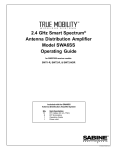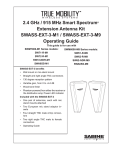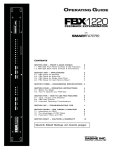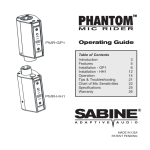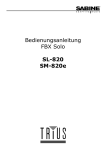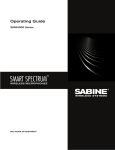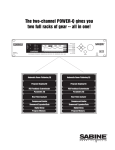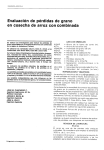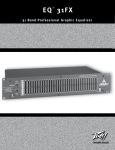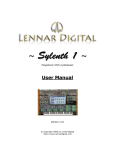Download SABINE FBX SOLO SL-610 Owner`s manual
Transcript
OPERATING GUIDE SL-610 SM-610 The Sabine FBX-SOLO models SM-610 and SL-610. CONGRATULATIONS! You now have the state-of-the-art in feedback control. The Sabine FBX-SOLO gives you automatic real-time feedback control for any channel on your mix, makes your system louder, and increases the clarity of your mains and monitors. It includes a user-selectable noise gate, especially useful in systems with a number of open microphones, such as courtrooms or conference rooms. The FBX-SOLO incorporates the latest in design and digital signal processing technology. It automatically senses feedback in a sound system and determines its pitch. It then places one of its six micro-filters on the resonating frequency and eliminates the feedback in typically less than one second. Before the invention of the FBX, the most common device for controlling feedback was the 31-band graphic EQ. However, the FBX has three distinct advantages. The most obvious is the FBX functions automatically, even during the program. Another is the FBX microfilters are precisely placed while EQ filters are fixed. The difference: FBX filters do not have to be as deep, so there is more system gain. The most important advantage is that FBX micro-filters are ten times narrower than 31-band EQ filters. FBX micro-filters return up to 90 percent of the power removed by EQ filters. Over the years, engineers stopped using 12-band EQs in favor of the narrower-filter 31band EQ for controlling feedback. The FBX represents the next step. An EQ would need more than 10,000 sliders to be equivalent to your FBX. With the SOLO, your monitors will finally sound loud enough, everyone in the audience will understand each word, and the mains will sound natural and transparent. FBX and FBX Feedback Exterminator are registered trademarks of Sabine, Inc., and are the brand names of its line of automatic feedback controllers. Covered by U.S. Patent No. 5,245,665, Australian Patent No. 653,736, and Canadian Patent No. 2,066,624-2. Other patents pending. ○ ○ ○ ○ ○ ○ ○ ○ ○ ○ ○ ○ ○ ○ ○ ○ ○ ○ ○ ○ ○ ○ ○ ○ ○ ○ ○ ○ A DIRECT HIT ON FEEDBACK! The FBX-SOLO targets feedback without taking a big chunk out of your sound. Tests prove that a single 1/3-octave EQ slider pulled down 12 dB removes almost half the power going to the speakers over a two-octave range. And, as the illustration at right shows, you can't place a graphic EQ filter precisely on the ringing frequency. When you pull down multiple sliders in a normal setup (below), you end up with giant holes in your sound. On the other hand, FBX micro-filters are 10 times narrower - you get back up to 90% of the power you lose with a graphic EQ! That means more gain before feedback and no loss in sound quality. ○ ○ ○ ○ ○ ○ ○ ○ ○ ○ ○ ○ ○ ○ ○ ○ ○ ○ ○ ○ ○ ○ ○ ○ ○ ○ ○ ○ ○ ○ ○ 0 dB 6 dB 12 dB 1000 Hz 500 Hz 2000 Hz 0.0 dBV FREQUENCY RESPONSE: Full Set-Up FBX vs. 1/3-Octave Graphic Equalizer. Test procedure: A PA system was -1.875 set up using a microphone, mixer, FBX, power amp and two speakers. The system's gain was raised until the FBX removed six feedback points. Next, the FBX was replaced with a 1/3-octave graphic EQ. The EQ was adjusted while the input was raised to the same level achieved with the FBX. The frequency response curves of each device were then plotted. -3.750 -5.625 -7.500 -9.375 -11.25 -13.13 -15.00 100 Hz 1K 10K What this means to you: Doubling the cost of your microphones, speakers and power amp probably would not improve your system's frequency response as much as replacing your EQ with an FBX for chasing feedback. HOW CAN THE SOLO BE USED? Assign a SOLO to any specific mixer channel. Use the SL-610 model for line level insert points on your mixer's inputs. Use the SM-610, which includes a microphone preamp and user-selectable phantom power, with mixers that don't have insert points. You can also use the SM-610 to connect a phantom-powered mic to a non-phantom-powered mixer. 2 Look for this symbol for specific information on the SL-610, for mixer insert points. Look for this symbol for specific information on the SM-610, for mic or instrument inputs. ○ ○ ○ ○ ○ ○ ○ ○ ○ ○ ○ ○ ○ ○ ○ ○ ○ ○ ○ ○ ○ ○ ○ ○ ○ ○ ○ ○ ○ ○ ○ ○ ○ ○ ○ ○ ○ ○ ○ ○ ○ ○ ○ ○ ○ ○ ○ ○ ○ ○ ○ ○ ○ ○ ○ ○ ○ ○ ○ INSTRUCTIONS FOR OPERATION Note: See pages 8 and 9 for front and back panel illustrations and descriptions. The FBX automatic feedback controller improves any sound reinforcement system. By following these simple instructions, you will be assured of the most benefit from your FBX and sound system. The instructions presume that you are familiar with the fundamentals of sound reinforcement. If any of the terms are not clear, or if the system does not perform as expected, contact your local Sabine dealer for further information. Read on for a basic explanation of FBX features you should understand before using your FBX. POWERING UP The only way to power up the FBX-SOLO is by connecting the power supply to the unit; there is no power switch on the FBX-SOLO. When connecting the power supply to the FBX-SOLO, push the connector into the input gently, with the lip facing up as shown. Do not force the connector into or out of the FBX. FIXED vs. DYNAMIC FILTERS The FBX has two types of filters: FIXED and DYNAMIC. FIXED FILTERS are set during the initial setup and retain their frequency center-points until the unit is reset by the user. The system’s gain before feedback is provided by the FIXED FILTERS; i.e., increasing the number of FIXED FILTERS increases the system’s gain before feedback. The FBX's DYNAMIC FILTERS control intermittent feedback that occurs during the program. They are continually reset automatically to different frequencies as new feedback occurs during the program. For many applications, the optimal setting is the one which gives maximum gain - i.e., four FIXED and two DYNAMIC filters (default setting). However, in some applications, such as use of wireless microphones, mobility is more important than maximum gain. In this case you may wish to set three fixed and three dynamic filters. The filters can be reconfigured easily from the factory default setting (four fixed and two dynamic). For example, the following procedure will set three filters fixed and three dynamic: 1. Place the unit in BYPASS mode. 2. Power down the SOLO. 3. While depressing the RESET button, power up the unit. 4. Release the RESET button. The FILTER INDICATOR LEDs will now light in sequence. 5. When the third LED is lit, press the RESET button. 6. Notice that the first three LEDs flash three times to verify that they are now the fixed filters. Note: The fixed filters flash three times whenever the FBX is powered up. WHERE TO PLACE THE SOLO IN YOUR SOUND SYSTEM SL-610: Patch the SL-610 into the insert point of the desired channel. If your mixer has a single connector insert point, connect the mixer to the IN/OUT connector on the SL-610 using one TRS (Tip=input/Ring=output/Sleeve=ground; 1/4" phone connector) cord. Otherwise, use the IN/OUT connector as the SL-610's input and the OUTPUT as the output. You can also use a Y-cord from a single connector insert point. (See page 10 of this manual for information on use with a guitar amplifier.) Use the following wiring diagrams (presented in order of most common to least common setup) as guides for setup: SL-610, Configuration 1: 3 ○ ○ ○ ○ ○ ○ ○ ○ ○ ○ ○ ○ ○ ○ ○ ○ ○ ○ ○ ○ ○ ○ ○ ○ ○ ○ ○ ○ ○ ○ ○ ○ ○ ○ ○ ○ ○ ○ ○ ○ ○ ○ ○ ○ ○ ○ ○ ○ ○ ○ ○ ○ ○ ○ ○ ○ ○ ○ SL-610, Configuration 2: SL-610, Configuration 3: SL-610, Configuration 4: SM-610: Connect your microphone or instrument directly to the SM-610 mic level input, and then connect the SM-610's line level output to an input on your mixer or amp. (See page 10 of this manual for information on use with a guitar amplifier.) The SM-610 input accepts both standard 1/4" phone and XLR input connectors. SM-610 Setup: 4 ○ ○ ○ ○ ○ ○ ○ ○ ○ ○ ○ ○ ○ ○ ○ ○ ○ ○ ○ ○ ○ ○ ○ ○ ○ ○ ○ ○ ○ ○ ○ ○ ○ ○ ○ ○ ○ ○ ○ ○ ○ ○ ○ ○ ○ ○ ○ ○ ○ ○ ○ ○ ○ ○ ○ ○ ○ ○ ○ ○ SL-610 SYSTEM INITIALIZING PROCEDURE Follow these steps to obtain the maximum gain before feedback without changing the tonal quality of your program. Set up only one SOLO at a time. The following instructions are for using the SOLO on the mains. For use with monitors, substitute monitor send and master monitor control for input channel level fader and mixer master output. Be sure to turn off the mains when initializing the SOLO in your monitor system. 11. Place the speakers and microphones in the positions where they will be used during the program. Avoid placing microphones directly in front of speakers. 2. Set the mixer master output, all channel level faders, and the monitors to minimum. 3. Turn on the SOLO by connecting the power supply to the SL-610. (There is no power switch.) 4. Turn on the mixer, any signal processing equipment, and finally the power amp. Press the SOLO's RESET button until the LEDs stop flashing to clear out filters set previously. 5. If you are using a graphic EQ, adjust it only for the desired tonal qualities. DO NOT NOTCH FOR FEEDBACK. 6. Be sure the SL-610 is in active mode. The "BY" LED will light green to indicate the SL-610 is active and red if it is in bypass mode. 7. To set the input channel clip level, play program material at nominal levels and adjust the mixer input gain control as high as possible without lighting either the channel or FBX CLIP LED. This will optimize the dynamic range of the SOLO with the channel of the mixer. 8. Set the mixer master output to a nominal level, and lower all channel levels to minimum. 9. Slowly raise the input channel level fader for the channel being set until feedback occurs. The SL-610 should quickly remove the feedback. The first FILTER LED will then blink to indicate a filter has been set. 10. Keep raising the level slowly until all FIXED FILTERS and one dynamic filter is set. Any uninitialized dynamic filters will be set later if feedback occurs during the program. 11. Now lower the channel level fader slightly so that the system is not on the verge of another feedback point. This is the maximum volume level that the SL-610 will be able to provide. Higher levels will cause uncontrollable feedback. Note: Once you become accustomed to this procedure, you will be able to set up your FBX in one or two minutes. SM-610 SYSTEM INITIALIZING PROCEDURE SM-610 Phantom Power Selection: Your SM-610 is delivered from the factory with the phantom power function enabled. If you do not wish to use phantom power - for example, if your microphone will be adversely affected by using phantom power - you may disable the function by opening the unit and switching the jumper. Please note: Phantom power does not affect mics with 1/4" input jacks. The majority of low impedance balanced non-phantom-powered mics are wired to ignore phantom power. Check your microphone owner's manual for verification to avoid damage. To defeat phantom power, follow these instructions: 1. Disconnect the power supply and remove the SM-610's MIC GAIN knob, nut and washer on the front panel. 2. Remove the back panel's four corner screws. Gently pull the back panel and printed circuit board assembly out of the unit. 3. Find the phantom power jumper, located between the XLR connector and the 1/4" connector. See the following diagram. (The jumper is shown in enabled position.) 5 ○ ○ ○ ○ ○ ○ ○ ○ ○ ○ ○ ○ ○ ○ ○ ○ ○ ○ ○ ○ ○ ○ ○ ○ ○ ○ ○ ○ ○ ○ ○ ○ ○ ○ ○ ○ ○ ○ ○ ○ ○ ○ ○ ○ ○ ○ ○ ○ ○ ○ ○ ○ ○ ○ ○ ○ ○ ○ ○ 4. Pull the jumper off the pins in phantom power enabled position, and push the jumper onto the pins in phantom power disabled position, as shown: 5. Carefully slide the printed circuit board and back panel assembly back into the unit, and re-insert the four corner screws. 6. Re-install the front panel nut, washer and MIC GAIN knob. To initialize the SM-610: Follow these steps to obtain the maximum gain before feedback without changing the tonal quality of your program. Set up only one SOLO at a time. The following instructions are for using the SOLO on the mains. For use with monitors, substitute monitor send and master monitor control for input channel level fader and mixer master output. Be sure to turn off the mains when initializing the SOLO in your monitor system. 1. Place the speakers and microphones in the positions where they will be used during the program. Avoid placing microphones directly in front of speakers. 12. Set the mixer master output, all channel level faders, and the monitors to minimum. 13. Turn on the SOLO by connecting the power supply to the SM-610. (There is no power switch.) Make sure the channel input is set for line, not microphone. Press RESET until the LEDs stop flashing to clear out filters set previously. 4. Turn on the mixer, any signal processing equipment, and finally the power amp. 15. If you are using a graphic EQ, adjust it only for the desired tonal qualities. DO NOT NOTCH FOR FEEDBACK. 6. Be sure the SM-610 is in active mode. The "BY" LED will light green to indicate the SM610 is in active mode and red if it is in bypass mode. 7. To set the SOLO clip level, play or talk into the connected microphone at nominal levels (if using the SM-610 with an electric/acoustic guitar, set the guitar's output control to maximum) and adjust the SOLO's MIC GAIN control as high as possible without lighting its red CLIP LED. Then adjust the SM-610 MIC GAIN control one click counter-clockwise to insure a margin of safety before clipping. If your mixer has an input gain control, adjust it to match the clip level of the SOLO. 8. Adjust the mixer's master output to a nominal level, usually 0dB. 9. Slowly raise the channel level fader for the channel being set until feedback occurs. The SM-610 should quickly remove the feedback. The first FILTER LED will then blink to indicate a filter has been set. (For use with electric/acoustic guitars, adjust the SM-610 MIC GAIN control fully clockwise at this point to speed up the filter-setting process. Return the MIC GAIN control to the previously determined level setting after initialization.) 10. Keep raising the channel level fader slowly until all FIXED FILTERS and one dynamic filter is set. Any uninitialized dynamic filters will be set later if feedback occurs during the program. 11. Now lower the channel level fader slightly so that the system is not on the verge of another feedback point. This is the maximum volume level the SM-610 will be able to provide. Higher levels will cause uncontrollable feedback. Note: Once you become accustomed to this procedure, you will be able to set up your FBX in one or two minutes. HOW TO USE THE "LOCK FIXED" FEATURE In certain situations the FBX may mistake music for feedback and drive the fixed filters deeper than necessary. Typical examples might be in a church with a pipe organ or during a performance with a great deal of intentional sustained electric guitar feedback. You may prevent the fixed filters from deepening beyond their initial depth by pressing the "LOCK FIXED" button on the front panel AFTER setting the fixed filters as described previously. The "LOCK FIXED" LED will light to indicate that the FBX is in "LOCK FIXED" mode. The fixed filters will stay locked until you press the "LOCK FIXED" button again. The dynamic filters are not affected. In almost every situation, it is best to lock the fixed filters right after the initial setup. 6 ○ ○ ○ ○ ○ ○ ○ ○ ○ ○ ○ ○ ○ ○ ○ ○ ○ ○ ○ ○ ○ ○ ○ ○ ○ ○ ○ ○ ○ ○ ○ ○ ○ ○ ○ ○ ○ ○ ○ ○ ○ ○ ○ ○ ○ ○ ○ ○ ○ ○ ○ ○ ○ ○ ○ ○ ○ ○ ○ LIMITING THE TOTAL NUMBER OF ACTIVE FILTERS You may choose to limit the total number of active filters for each application by using the "LOCK FIXED" button. For example, if you wish to use only three fixed and one dynamic filter, set the FBX so there are five fixed and one dynamic filter. Then during the setup procedure, simply press the "LOCK FIXED" button after setting the first three fixed filters. The remaining two fixed filters will be locked in their zero position. SELECTING FILTER WIDTH If the SOLO is to be used for a music application, 1/10-octave filters are most effective. However, in spoken word applications, such as lectures or teleconferencing, the wider 1/5octave filters are recommended. Select the filter width using the switch on the SOLO back panel. The change takes effect only on power-up. Selecting a new width has no effect unless you power down and then power up again. ENGAGING THE NOISE GATE One outstanding feature of your FBX-SOLO is a user-selectable noise gate. It acts as an automatic switch that opens a microphone only when someone is speaking directly into the mic. A noise gate is especially useful in systems that have a number of open microphones, such as courtrooms, conference rooms, or parliament buildings. Gating microphones greatly reduces the number of possible feedback points in the room and allows for more system gain. The level that turns the noise gate on and off is called the threshold. If the level coming into the gate is greater than the threshold, the noise gate opens, and the mic is turned on. If it is less than the threshold, the noise gate closes, and the mic is turned off. You can adjust your SOLO to four different threshold levels (see diagram at right), or turn it off. To select the threshold, power down the SOLO. Hold in the LOCK FIXED button, and power up the SOLO. The clip level LEDs will light in sequence. Select the threshold level by pressing the LOCK FIXED button again when the clip LED lights at the corresponding threshold level. The noise gate is now enabled, indicated by a flashing level LED on powerup. Pressing the LOCK FIXED button with no clip LEDs lighted turns off the noise gate. If no lights flash on power-up, the noise gate is not engaged. When the SOLO's noise gate is enabled, it will not become engaged until after you've set all fixed filters and one dynamic filter (if the SOLO is configured for any). USING SABINE'S OPTIONAL SOLO ACCESSORIES 1-U rack tray (model #SL6RACK): An optional 1-U rack tray holds up to six SOLOs. Mount the SL-610s, SM-610s, or a combination of both side by side on the tray. Use only Sabine supplied screws; use of any other screws may damage the SOLO and void the warranty. 7 ○ ○ ○ ○ ○ ○ ○ ○ ○ ○ ○ ○ ○ ○ ○ ○ ○ ○ ○ ○ ○ ○ ○ ○ ○ ○ ○ ○ ○ ○ ○ ○ ○ ○ ○ ○ ○ ○ ○ ○ ○ ○ ○ ○ ○ ○ ○ ○ ○ ○ ○ ○ ○ ○ ○ ○ ○ ○ ○ SL-610 Front & Back Panels ACTIVE/BYPASS Bypass mode takes the unit out of the signal path so that it will have no effect on the program. In Active mode, the unit controls feedback automatically. The two-color "BY" LED lights green when the unit is in Active mode and lights red when in Bypass mode. RESET Press until the LEDs stop flashing to reset or clear all filters. FILTER ACTIVITY When one of the unit’s filters is activated, the corresponding LED lights. A blinking LED indicates the filter that was most recently activated. LOCK FIXED FILTERS When the "LOCK FIXED" button is pressed, its LED will light to indicate that the FBX is in "LOCK FIXED" mode. "LOCK FIXED" mode can be activated at any time after system setup and will stay on until the button is pressed again and the LED turns off. 12VDC ADAPTOR The FBX external power supply (single unit power supply; model #S-PSU1) is included with the unit. Use of any other power supplies may cause permanent damage to the unit and WILL VOID THE WARRANTY. INPUTS & OUTPUTS The connector labeled IN/OUT serves as both the unit's input (tip) and output (ring) when used with a single TRS plug. When used with a Y-cord, use the IN/OUT as the input and the OUTPUT as the output. FILTER WIDTH SWITCH Switch to narrow 1/10-octave filters for music applications or to wider 1/5-octave filters for spoken word applications. The change takes effect only on power up. Selecting a new width has no effect unless you power down and then power up again. MEMORY: The FBX stores the positions and depths of the filters in nonvolatile internal memory when the unit is turned off or during a power failure. The unit will return all filters to their previous frequencies and depths when it is turned back on. BYPASS MODE: The SL-610 has a true power-off bypass. The signal is unaffected in bypass mode even if the unit is turned off. If the unit is in active mode, no signal will pass if the power is off. Placing the SM-610 in bypass mode only shuts down the FBX function; the microphone preamp still functions when the unit is in bypass mode. The SM-610 will not pass signal if the power is off in either active or bypass mode. RESETTING THE FILTERS: The user must reset the FBX if the microphones or speakers are moved significantly. To reset the unit, press RESET until the LEDs stop flashing. POWER DOWN: Place the unit in BYPASS MODE before removing power from the unit. 8 ○ ○ ○ ○ ○ ○ ○ ○ ○ ○ ○ ○ ○ ○ ○ ○ ○ ○ ○ ○ ○ ○ ○ ○ ○ ○ ○ ○ ○ ○ ○ ○ ○ ○ ○ ○ ○ ○ ○ ○ ○ ○ ○ ○ ○ ○ ○ ○ ○ ○ ○ ○ ○ ○ ○ ○ ○ ○ ○ SM-610 Front & Back Panels ACTIVE/BYPASS In Active mode, the unit controls feedback automatically. The two-color "BY" LED lights green when the unit is in Active mode and lights red when in Bypass mode. Phantom power and the mic preamp remain active in Bypass mode; only the FBX function is bypassed. RESET Press until the LEDs stop flashing to reset or clear all filters. FILTER ACTIVITY When one of the unit’s filters is activated, the corresponding LED lights. A blinking LED indicates the filter that was most recently activated. LOCK FIXED FILTERS When the "LOCK FIXED" button is pressed, its LED will light to indicate that the FBX is in "LOCK FIXED" mode. "LOCK FIXED" mode can be activated at any time after system setup and will stay on until the button is pressed again and the LED turns off. 12VDC ADAPTOR The FBX external power supply (single unit power supply; model #S-PSU1) is included with the unit. Use of any other power supplies may cause permanent damage to the unit and WILL VOID THE WARRANTY. INPUT The input accepts unbalanced TS (Tip/Sleeve) 1/4" phone plug, balanced TRS (Tip/Ring/Sleeve) 1/4" phone plug, or balanced XLR-3 (PIN 2 high) plug. OUTPUT Use unbalanced TS 1/4" phone plug for unbalanced mixer line inputs. Use balanced TRS 1/4" phone plug (tip high) for balanced mixer line inputs. FILTER WIDTH SWITCH Switch to narrow 1/10-octave filters for music applications or to wider 1/5-octave filters for spoken word applications. The change takes effect only on power up. Selecting a new width has no effect unless you power down and then power up again. MIC GAIN Use this to control the microphone preamp level. Adjust it as high as possible without lighting the SOLO's red CLIP LED. MEMORY: The FBX stores the positions and depths of the filters in nonvolatile internal memory when the unit is turned off or during a power failure. The unit will return all filters to their previous frequencies and depths when it is turned back on. BYPASS MODE: The SL-610 has a true power-off bypass. The signal is unaffected in bypass mode even if the unit is turned off. If the unit is in active mode, no signal will pass if the power is off. Placing the SM-610 in bypass mode only shuts down the FBX function; the microphone preamp still functions when the unit is in bypass mode. The SM-610 will not pass signal if the power is off in either active or bypass mode. RESETTING THE FILTERS: The user must reset the FBX if the microphones or speakers are moved significantly. To reset the unit, press RESET until the LEDs stop flashing. POWER DOWN: Place the unit in BYPASS MODE before removing power from the unit. 9 ○ ○ ○ ○ ○ ○ ○ ○ ○ ○ ○ ○ ○ ○ ○ ○ ○ ○ ○ ○ ○ ○ ○ ○ ○ ○ ○ ○ ○ ○ ○ ○ ○ ○ ○ ○ ○ ○ ○ ○ ○ ○ ○ ○ ○ ○ ○ ○ ○ ○ ○ ○ ○ ○ ○ ○ ○ ○ ○ TROUBLESHOOTING TIPS Q. Can I patch the SOLO SL-610 after the mixer and before the power amp, just like an FBX-901 or 1802? A. There are two reasons why this configuration won't work. First, you will have no way to set the clip level of the SOLO. The SOLO SL-610 is designed to function as an insert device -- you adjust the gain trim on the channel to match the clip level of the SOLO. Second, the SOLO has only six FBX filters, which may not provide enough gain before feedback for your entire mix. Q. What is the best way to use the SOLO with a guitar amplifier? A. To use the SL-610 with a guitar amplifier, the amplifier must be equipped with either an INSERT POINT or PREAMP OUT/POWER AMP IN jacks. Connect the amplifier's PREAMP OUT to the SL-610 INPUT, and the SL-610 OUTPUT to the amplifier's POWER AMP INPUT. To use the SM-610 with an amplifier, connect the SM-610 OUTPUT to the instrument amplifier LOW GAIN or HIGH LEVEL input. (Use an input that can handle line level input levels.) Q. The CLIP LEVEL LEDs do not light. The unit will not catch feedback. Why? A. The unit is not in the signal path. Check the connections. Q. Why does one of the FILTER ACTIVITY LEDs blink? A. The last filter to be automatically updated blinks. During normal operation, the blinking will move from filter to filter as the SOLO finds new feedback points. This gives the user a visual confirmation that the unit is functioning properly. Q. Why would the FBX cause a noticeable hum? A. It may hum if the system is improperly grounded. Check for bad grounds. Q. Why does my system sound thin and muffled? A. Place the SOLO in BYPASS MODE. If the system still sounds thin, your problem is probably with improper use of a graphic EQ. If the problem exists only with the SOLO in ACTIVE mode, verify the clip level setting, reinitialize the system and lock the fixed filters. Q. With the SL-610 in the insert point, I hear no audio. Why? A. Your insert point may be wired opposite to the SOLO. Try reversing the tip and ring (in and out) of your Y-cord. If you are using a single TRS cable, you will have to reconfigure one end of it to conform to your mixer insert point. Q. Will the SOLO eliminate feedback in both mains and monitors? A. Yes, but you should only set fixed filters for either mains or monitors, not both. Choose which system is more likely to have feedback, and follow the system initializing procedure for either mains or monitors. During program, the dynamic filters will control feedback for both mains and monitors if they are in use, but only on the input channel the SOLO is patched into. Q. The channel I have the SOLO in seems noisy. What can I do? A. If the noise floor is too high, you need to readjust the gain structure of that channel. Follow the SOLO initialization instructions in this guide. 10 ○ ○ ○ ○ ○ ○ ○ ○ ○ ○ ○ ○ ○ ○ ○ ○ ○ ○ ○ ○ ○ ○ ○ ○ ○ ○ ○ ○ ○ ○ ○ ○ ○ ○ ○ ○ ○ ○ ○ ○ ○ ○ ○ ○ ○ ○ ○ ○ ○ ○ ○ ○ ○ ○ ○ ○ ○ ○ ○ ENGINEERING SPECIFICATIONS Filters Six independent digital notch filters controlled automatically from 51Hz to 17,000Hz Filter width: 1/10 octave, typical, or 1/5-oct. selectable Filter depth: DSP controlled, variable to -50dB Resolution: 1/20 octave or better Time required to find and eliminate feedback: 0.4 seconds, typical @ 1KHz Total number of combined filters active: User selectable, from 1 to 6 Number of Dynamic vs. Fixed filters: User selectable Last configuration stored in memory Input/output - SL610 ONLY Input Impedance: Unbalanced 10K Ohms Output Impedance: Unbalanced 10 Ohms nominal; Maximum load 2K Ohms Input/Output Maximum Signal Levels: Unbalanced +14dBV peak at clip; 11dBV RMS I/O Connectors: 1/4" TRS; tip=input, ring=output, sleeve=ground Bypass: True Power Off Bypass; Unbalanced to Unbalanced Input/output - SM610 ONLY Input: Combination 1/4" TRS & XLR-3 PIN 2 high Balanced Input Impedance: 1 meg Ohm Gain Range: 8 to 40dB Maximum Input Level at lowest gain: +6dBV peak 48V phantom power jumper selectable (available on XLR input only) Output: 1/4"; tip high, sleeve ground Output Impedance: Unbalanced 10 Ohms nominal; Maximum load 2K Ohms Output Level: Unbalanced +14dBV peak at clip nominal Bypass: Affects FBX function only; mic preamp stays on. EIN: -105dBm @ 150 Ohms, 20Hz-17KHz or better PERFORMANCE* Frequency Response: < +0.5dB, 20Hz to 17,000Hz Signal to Noise Ratio: >85dB typical Total Harmonic Distortion: <0.015% @ 1KHz @ any gain setting Dynamic Range: >92dB POWER SUPPLY 8-20VDC @ 400 mA MEMORY BATTERY LIFE 7 years, typical DIMENSIONS 1-U height, 1/6-RU width; 2.78 x 1.65 x 5.5 in. (6.95 x 4.13 x 13.75 cm) WEIGHT 9 oz. (0.26 kg) OPTIONS Rack tray (holds up to six units) *Tests performed using an Audio Precision System One model 322 or equal. (SPECIFICATIONS SUBJECT TO CHANGE WITHOUT NOTICE) CAUTIONS: EXPOSURE TO EXTREMELY HIGH NOISE LEVELS MAY CAUSE A PERMANENT HEARING LOSS. INDIVIDUALS VARY CONSIDERABLY IN SUSCEPTIBILITY TO NOISE INDUCED HEARING LOSS, BUT NEARLY EVERYONE WILL LOSE SOME HEARING IF EXPOSED TO SUFFICIENTLY INTENSE NOISE FOR A SUFFICIENT TIME. THE U.S. GOVERNMENT'S OCCUPATIONAL SAFETY AND HEALTH ADMINISTRATION (OSHA) HAS SPECIFIED THE FOLLOWING PERMISSIBLE NOISE LEVEL EXPOSURES: DURATION/DAY IN HOURS 8 6 4 3 2 1-1/2 1 1/2 1/4 or less SOUND LEVEL IN dBA, SLOW RESPONSE 90 92 95 97 100 102 105 110 115 ACCORDING TO OSHA, ANY EXPOSURE IN EXCESS OF THE ABOVE PERMISSIBLE LIMITS COULD RESULT IN HEARING LOSS. EAR PLUGS OR PROTECTORS IN THE EAR CANALS OR OVER THE EARS MUST BE WORN WHEN OPERATING THIS DEVICE IN ORDER TO PREVENT A PERMANENT HEARING LOSS. IF EXPOSURE IS IN EXCESS OF THE LIMITS AS SET FORTH ABOVE, TO ENSURE AGAINST POTENTIALLY DANGEROUS EXPOSURE TO HIGH SOUND PRESSURE LEVELS, IT IS RECOMMENDED THAT ALL PERSONS EXPOSED TO EQUIPMENT CAPABLE OF PRODUCING HIGH SOUND PRESSURE LEVELS SUCH AS THIS DEVICE BE PROTECTED BY HEARING PROTECTORS WHILE THIS UNIT IS IN OPERATION. 1. Read all safety and operating instructions before using this product. 2. All safety and operating instructions should be retained for future reference. 3. Obey all cautions in the operating instructions and on the unit. 4. All operating instructions should be followed. 5. This product should not be used near water, i.e a bathtub, sink, swimming pool, wet basement, etc. 6. This product should be located so that its position does not interfere with its proper ventilation. It should not be placed flat against a wall or placed in a built-in enclosure that will impede the flow of cooling air. 7. This product should not be placed near a source of heat such as a stove or radiator. 8. Connect only to a power supply of the type marked on the unit adjacent to the power. 9. Never break off the ground pin on the power supply cord. 10. Power supply cords should always be handled carefully. Never walk or place equipment on power supply cords. Periodically check cords for cuts or signs of stress, especially at the plug and the point where the cord exits the unit. 11. The power supply cord should be unplugged when the unit is to be unused for long periods of time. 12. Care should be taken so that objects do not fall and liquids are not spilled into the unit through the ventilation holes or any other openings. 13. This unit should be checked by a qualified service technician if: A. The power supply cord or plug has been damaged. B. Anything has fallen or been spilled into the unit. C. The unit does not operate correctly. D. The unit has been dropped or the enclosure damaged. 14. The user should not attempt to service this equipment. All service work should be done by a qualified service technician. 11 ○ ○ ○ ○ ○ ○ ○ ○ ○ ○ ○ ○ ○ ○ ○ ○ ○ ○ ○ ○ ○ ○ ○ ○ ○ ○ ○ ○ ○ ○ ○ ○ ○ ○ ○ ○ ○ ○ ○ ○ ○ ○ ○ ○ ○ ○ ○ ○ ○ ○ ○ ○ ○ ○ ○ ○ ○ ○ ONE-YEAR LIMITED WARRANTY: THIS LIMITED WARRANTY VALID ONLY WHEN PURCHASED AND REGISTERED IN THE UNITED STATES OR CANADA. ALL EXPORTED PRODUCTS ARE SUBJECT TO WARRANTY AND SERVICES TO BE SPECIFIED AND PROVIDED BY THE AUTHORIZED DISTRIBUTOR FOR EACH COUNTRY. Ces clauses de garantie ne sont vaiables qu’aux Etats-Unis et au Canada. Dans tous les autres pays, les clauses de garantie et de maintenance sont fixees par le distributeur national et assuree par lui selon la legislation en vigueur. Diese Garantie ist nur in den USA and Kanada gultig. Alle ExportProdukte sind der Garantie und dem Service des Importeurs des jewelligen Landes untervorfen. Esta garantia es valida solamente cuando el producto es comprado en E.U. continentales o en Canada. Todos los productos que sean comprados en el extranjero, estan sujetos a las garantias y servicio que cada distribuidor autorizado determine y otrezca en los diterentes paises. ONE-YEAR LIMITED WARRANTY/REMEDY SABINE, INC. (“SABINE”) warrants this product to be free from defects in material and workmanship for a period of one (1) year from date of purchase PROVlDED, however, that this limited warranty is extended only to the original retail purchaser and is subject to the conditions, exclusions and limitations hereinafter set forth: CONDITIONS, EXCLUSIONS AND LIMITATIONS OF LIMITED WARRANTIES These limited warranties shall be void and of no effect if: a. The first purchase of the product is for the purpose of resale; or b. The original retail purchase is not made from an AUTHORIZED SABINE DEALER; or c. The product has been damaged by accident or unreasonable use, neglect, improper service or maintenance, or other causes not arising out of defects in material or workmanship; or d. The serial number affixed to the product is altered, defaced or removed; or e. The power supply grounding pin is removed or otherwise defeated. In the event of a defect in material and/or workmanship covered by this limited warranty, Sabine will repair the defect in material or workmanship or replace the product, at Sabine’s option; and provided, however, that, in any case, all costs of shipping, if necessary, are paid by you, the purchaser. THE WARRANTY REGISTRATION CARD SHOULD BE ACCURATELY COMPLETED, MAILED TO AND RECEIVED BY SABINE WITHIN FOURTEEN (14) DAYS FROM THE DATE OF YOUR PURCHASE. In order to obtain service under these warranties, you must: a. Bring the defective item to any AUTHORlZED SABlNE DEALER and present therewith the ORIGINAL PROOF OF PURCHASE supplied to you by the AUTHORIZED SABINE DEALER in connection with your purchase from him of this product. If the DEALER is unable to provide the necessary warranty service, you will be directed to the nearest other SABINE AUTHORIZED DEALER which can provide such service. OR b. Call Sabine for a RETURN AUTHORIZATION NUMBER and ship the defective item, prepaid, to: SABINE, INC. 13301Highway 441 Alachua, FL 32615 including therewith a complete, detailed description of the problem, together with a legible copy of the original PROOF OF PURCHASE and a complete return address. Upon Sabine’s receipt of these items: If the defect is remedial under the limited warranties and the other terms and conditions expressed have been complied with, Sabine will provide the necessary warranty service to repair or replace the product and will return it, FREIGHT COLLECT, to you, the purchaser. Sabine’s liability to the purchaser for damages from any cause whatsoever and regardless of the form of action, including negligence, is limited to the actual damages up to the greater of $500.00 or an amount equal to the purchase price of the product that caused the damage or that is the subject of or is directly related to the cause of action. Such purchase price will be that in effect for the specific product when the cause of action arose. This limitation of liability will not apply to claims for personal injury or damage to real property or tangible personal property allegedly caused by Sabine’s negligence. Sabine does not assume liability for personal injury or property damage arising out of or caused by a non-Sabine alteration or attachment, nor does Sabine assume any responsibility for damage to interconnected non-Sabine equipment that may result from the normal functioning and maintenance of the Sabine equipment. UNDER NO CIRCUMSTANCES WILL SABINE BE LIABLE FOR ANY LOST PROFITS, LOST SAVINGS, ANY INCIDENTAL DAMAGES OR ANY CONSEQUENTIAL DAMAGES ARISING OUT OF THE USE OR INABILITY TO USE THE PRODUCT, EVEN IF SABINE HAS BEEN ADVISED OF THE POSSIBILITY OF SUCH DAMAGES. THESE LIMITED WARRANTIES ARE IN LIEU OF ANY AND ALL WARRANTIES, EXPRESS OR IMPLIED, INCLUDING BUT NOT LIMITED TO, THE IMPLIED WARRANTIES OF MERCHANTABILITY AND FITNESS FOR A PARTICULAR USE; PROVIDED, HOWEVER, THAT IF THE OTHER TERMS AND CONDITIONS NECESSARY TO THE EXISTENCE OF THE EXPRESS LIMITED WARRANTIES, AS HEREINABOVE STATED, HAVE BEEN COMPLIED WITH, IMPLIED WARRANTIES ARE NOT DISCLAIMED DURING THE APPLICABLE ONE-YEAR PERIOD FROM DATE OF PURCHASE OF THIS PRODUCT. SOME STATES DO NOT ALLOW LIMITATION ON HOW LONG AN IMPLIED WARRANTY LASTS, OR THE EXCLUSION OR LIMITATION OF INCIDENTAL OR CONSEQUENTIAL DAMAGES, SO THE ABOVE LIMITATIONS OR EXCLUSIONS MAY NOT APPLY TO YOU. THESE LIMITED WARRANTIES GIVE YOU SPECIFIC LEGAL RIGHTS, AND YOU MAY ALSO HAVE OTHER RIGHTS WHICH MAY VARY FROM STATE TO STATE. THESE LIMITED WARRANTIES ARE THE ONLY EXPRESS WARRANTIES ON THIS PRODUCT, AND NO OTHER STATEMENT, REPRESENTATION, WARRANTY OR AGREEMENT BY ANY PERSON SHALL BE VALID OR BINDING UPON SABINE. In the event of any modification or disclaimer of express or implied warranties, or any limitation of remedies, contained herein conflicts with applicable law, then such modification, disclaimer or limitation, as the case may be, shall be deemed to be modified to the extent necessary to comply with such law. Your remedies for breach of these warranties are limited to those remedies provided herein, and Sabine gives this limited warranty only with respect to equipment purchased in the United States of America. INSTRUCTIONS-WARRANTY REGISTRATION CARD 1. Mail the completed WARRANTY REGISTRATION CARD to: SABINE, INC. 13301Highway 441 Alachua, FL 32615 a. Keep the PROOF OF PURCHASE. In the event warranty service is required during the warranty period, you will need this document. There will be no identification card issued by Sabine, Inc. 2. IMPORTANCE OF WARRANTY REGISTRATION CARDS AND NOTIFICATION OF CHANGES OF ADDRESS: a. Completion and mailing of WARRANTY REGISTRATION CARDS Should notification become necessary for any condition that may require correction, the REGISTRATION CARD will help ensure that you are contacted and properly notified. b. Notice of address changes - If you move from the address shown on the WARRANTY REGISTRATION CARD, you should notify Sabine of the change of address so as to facilitate your receipt of any bulletins or other forms of notification which may become necessary in connection with any condition that may require dissemination of information or correction. 3. You may contact Sabine directly by telephoning (904) 371-3829. 4. Please have the Sabine product name and serial number available when communicating with Sabine Customer Service. MADE IN USA. *FBX Feedback Exterminator is a registered trademark of Sabine, Inc., and is the brand name of its line of automatic feedback controllers. Covered by U.S. Patent No. 5,245,665. Other patents pending. Manufactured by: Sabine, Inc. • 13301 Highway 441 • Alachua, FL 32615 USA • Phone: (904) 418-2000 • Fax: (904) 418-2001 www.SabineUSA.com FBX-SOLO-610-072500.p65 ○















